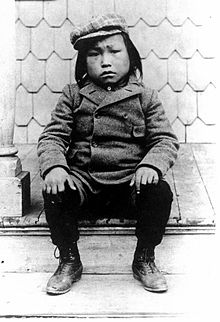By Charles J. Hanley
Today it's the descendants of those boys who are exploring the world.
“He said, 'I'll find the way or I'll make a way.' That's what I'm doing, too,” Robert E. Peary II, 55, a well-traveled Inuit lecturer-performer, says of his famous great-grandfather, Rear Adm. Robert E. Peary.
Those bearing Matthew A. Henson's name–Peary's chief aide–are venturing beyond their remote Greenland birthplaces as well.
“I have that feeling, I want to be traveling always,” says Avo Henson Sikemsen, 27, who recalls dogsled trips from her Arctic village as a girl, but who has since seen the world, from Cairo to New York. One cousin is even off to Harvard.
Over four generations, the two family lines, rooted in the planet's northernmost communities, have multiplied, spread out, even intermarried, and are now plugging in to a globalizing world.
Peary and Henson both fathered children with Inuit women outside of marriage. (So did many other European explorers of the Arctic; for example, Robert J. Flaherty fathered a son during the filming of Nanook of the North.) This was brought up by Cook and his followers during Peary's lifetime and would have damaged his advancement if it had been widely believed. Peary appears to have started his relationship with his Inuit wife Aleqasina (Alakahsingwah) when she was about 14 years old. Furthermore, Peary's main financial backer was New York philanthropist Morris Ketchum Jesup, a major force in the founding of Anthony Comstock's New York Society for the Suppression of Vice. Many of the explorers knew the facts, but had no wish to mention them publicly, in case this endangered their financial backing by scandal-shy geographical societies or their own Inuit relationships.
By the 1960s the truth was widely acknowledged, and Peary’s son Kali was eventually brought to the attention of the broader American public by S. Allen Counter, who met him on a North America expedition. The "discovery" of these children and their meeting with their American relatives were documented in a book and documentary titled North Pole Legacy: Black, White and Eskimo.
In 1897, Robert Peary brought the Inuit Qisuk, his son Minik, and four members of the Northern Greenland band to the American Museum of Natural History in New York. Although Peary had invited the adults on the trip, it is unlikely they were clearly informed as to its purpose. Some agreed to travel to see new places; others did not want to be parted from relatives. Peary had promised that they would be able to return to Greenland. Soon after their arrival, the group became the objects of study, together with a meteorite which Peary had brought. The museum staff had not made plans for their care, nor for their return.
Wikipedia also notes the four Inuit who accompanied Peary and Henson: Ootah, Egigingwah, Seegloo, and Ooqueah. As noted in Icy Indigenous Expeditions, they should get co-credit for accompanying the foreigners and, more important, teaching them how to survive.
Not only did the Inuit teach and guide them, but they apparently provided a whole support system. They fed, sheltered, and comforted (slept with) the strangers. It's a lot easier crossing foreign territory when you have a whole village helping you out.
When we talk about explorers like Peary, we should compare them to someone like Neil Armstrong. Yes, he was the first man on the moon, but he didn't do anything noteworthy by himself. He was the culmination of decades of work, supported by an infrastructure of thousands. It's more correct to say the space program put a man on the moon and it just happened to be Armstrong.
Same with Peary. With all the people funding him and all the Inuit helping him, he doesn't deserve much of the glory. But we do glorify lone explorers like him, of course. Many Inuit may have reached the North Pole, but it doesn't count unless a Westerner did it. And he gets the credit even though the Inuit kept him alive.
"Studying" = stealing
Meanwhile, I can just imagine Peary sweet-talking the Inuit into accompanying him back to America. "No, you won't catch horrible diseases you've never been exposed to. We'll take care of all your wants and needs while you're with us. We'll return you promptly to your homes. And if you die, we wouldn't dream of putting your bones on display like zoological specimens."
It's a good example of Western civilization's Indiana Jones/Froot Loops mentality. If we want some Inuit people and a meteorite to study, we take them. In the case of the people, we'll make promises to them equivalent to lies, or simply kidnap them. It doesn't matter if they get sick or die and never return. What matters is what white men want!
No doubt this history is well-known to Arctic aficionados, but a lot of it is new to me. So I'm sharing it.
For more on Arctic explorers, see:
Frankenstein's monster = Eskimo
Charles Dickens on "Esquimaux"
The "Other" and The Terror
The doomed Franklin expedition
Review of Arctic Passage: Ice Survivor
Below: Minik Wallace.


1 comment:
This is a good starting article for me as I am doing a paper on human zoos. I had no idea that Peary did this and I would like to know if you can provide me with your resources, books, journal articles etc... I would appreciate any information you can give me.
Sincerely, Melanie Corp
Post a Comment